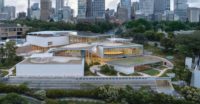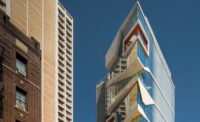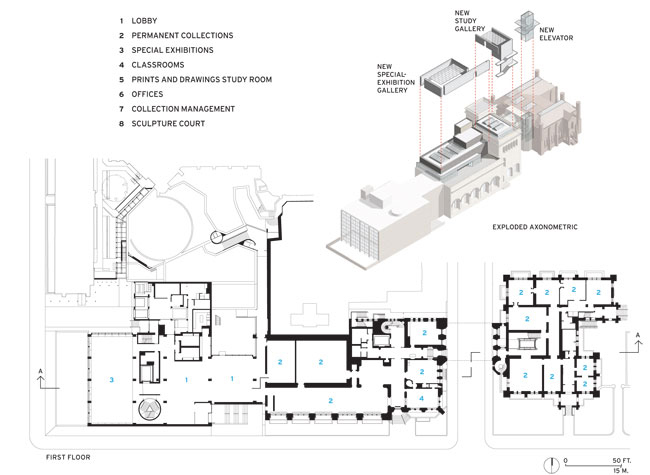Yale University Art Gallery Renovation and Expansion
Stitches in Time: A well-executed renovation, along with a few carefully conceived insertions, weaves together a museum’s trio of stylistically distinct landmarks.

The museum consists of three connected structures by (from left to right) Louis I. Kahn (1953), Egerton Swartwout (1928), and Peter Bonnett Wight (1866).
Photo © Chris Gardner

One of the many galleries is a vaulted space in Swartwout’s building.

Image courtesy Ennead Architects

Image courtesy Ennead Architects

The project includes some new construction, such as a stair-wrapped elevator that is clearly differentiated from the nearby traditional wainscoted galleries by its glass cab and shaft.

A new rooftop gallery for temporary exhibitions is decidedly modern. It has a wavelike resin ceiling that appears to float and diffuses daylight entering the room through a skylight.

On the outside, the glass-and-zinc-clad addition for the temporary exhibition gallery is set back from the existing parapet to make it almost undetectable from the street. The move also allows space for a sculpture terrace.

A solid masonry wall has little insulation value. As a result, a microclimate can form behind wall-hung artwork. The temperature behind a wood-framed painting, for example, can be as much as 15 degrees Fahrenheit lower than the temperature of the room, which can lead to condensation. To address the problem, designers created a vented cavity on the inside face of Swartwout’s and Street’s exterior masonry walls.
Thermal diagrams courtesy Simpson Gumpertz & Heger; Axonometric courtesy Ennead Architects

Most visitors will be unaware of many of the museum’s technical enhancements. They will not be able to tell, for instance, that a set of stone columns in one of the modern and contemporary art galleries has been moved to make way for a new service core.

Visitors will also be unlikely to notice the small, continuous slot between the baseboard and the floor in one of the American painting and sculpture galleries, which hints at the existence of a vented wall cavity.

As part of the first phase of the museum’s renovation, the project team replaced the Kahn building’s condensation-plagued steel-and-glass window wall. The new thermally broken aluminum mullions replicate exactly the dimensions of the originals on the exterior.

Image courtesy Ennead Architects

Inside the galleries devoted to the early Renaissance 13th- and 14th-century Tuscan paintings seem to pop from deep purple walls.

The galleries inside the Kahn building, defined by their tetrahedral ceilings of reinforced concrete, are low but loft-like.

The laylights topping one of the Street Hall galleries had been covered over to turn the space into a lecture hall. But as part of the renovation, the room has been returned to its original splendor.















Architects & Firms
New Haven, Connecticut
The Yale University Art Gallery (YUAG) is inaptly named. The word “gallery” doesn't convey the institution's size and its almost encyclopedic scope, with holdings that number more than 200,000 objects encompassing an array of eras, cultures, and media. Since completion in December of a sensitively executed renovation and expansion by Ennead Architects, about 4,000 pieces of this extensive collection are on display in the YUAG's three contiguous, but very different, buildings that stretch the length of one and a half New Haven city blocks. The oldest is the brownstone Street Hall, a Ruskinian Gothic building designed by Peter Bonnett Wight and completed in 1866. The youngest is a 60-year-old Modernist brick-glass-and-concrete structure by Louis I. Kahn. And sandwiched in between is the Old Yale Art Gallery, a sandstone-clad Italianate Gothic building completed in 1928, often referred to as “Swartwout” for its designer, Egerton Swartwout.
The $135 million revamp, which has increased exhibition space by more than 70 percent to almost 70,000 square feet, reclaims areas that had been occupied by other departments, updates antiquated building systems, and addresses general deterioration caused by a combined 280 years of deferred maintenance among the three structures, according to a tally by Jock Reynolds, the YUAG's director. But most significantly, the project unites the landmarks while preserving their distinct characters. “We were not trying to homogenize the buildings,” explains Ennead design partner Richard Olcott.
The result is a museum with galleries almost as diverse as its collection—work that includes ancient Greek and Roman sculpture, Indonesian textiles, and Cubist paintings. And although not every piece in the collection is a standout, there are many genuine masterpieces. Among them are Vincent van Gogh's oil The Night Café, which depicts bottle-strewn tables surrounding a lone pool player under lurid light; Thomas Eakins's monumental canvas Taking the Count, which shows a downed boxer struggling to get up during a match; and a trio of Piet Mondrian's Compositions—to name just a few.
Some of the museum's spaces, like a 21-foot-tall, laylight-topped gallery for American painting and sculpture, are stately and grand. Others, such as the galleries devoted to the early Renaissance, where 13th- and 14th-century Tuscan paintings seem to pop from deep-purple walls, are quirky and intimate. And the galleries in the Kahn building, defined by their muscular tetrahedral ceilings of reinforced concrete, are low but loftlike. This variety doesn't produce a mishmash of competing architectural styles, but instead creates a satisfying assortment of environments.
Ennead's involvement with the project began in 1995, when Yale hired the firm (then known as Polshek Partnership) to assess the condition of the Kahn building. Ennead was then asked to create a master plan for the part of campus that is home to the university's visual- and performing-arts institutions such as the Yale Center for British Art, the School of Architecture, and the Repertory Theater. Eventually the assignment grew to include the commission for the multiphased overhaul of all three structures that now make up the YUAG. The university undertook renovation of the Kahn building first, reopening it in 2006, before moving on to Street and Swartwout.
In addition to renovation, the project also encompassed several carefully considered interventions—a stair-wrapped elevator and two new skylit galleries for special exhibitions. These are, for the most part, hidden from the outside: the elevator is buried within Street, while the smaller of the two new galleries has been inserted, with the help of some structural gymnastics, inside the previously almost empty shell of a tower at Swartwout's southeast corner. Glimpses of the larger gallery, which sits on Swartwout's roof, are visible from some vantage points. However, the architects chose to set the glass-and-zinc-clad addition back 25 feet from the existing parapet, a move that makes the new gallery inconspicuous and provides space for a sculpture terrace.
If the insertions are unobtrusive on the exterior, inside they are intentionally differentiated from the historic fabric. Ennead explored several designs for the elevator, including a Gothic option, says Duncan Hazard, the firm's management partner. However, the end product is appropriately 21st century: the shaft is defined by luminous glass panels, clearly distinguishing it from the surrounding wainscoted galleries. Similarly, the added white-box galleries are decidedly modern, with gently undulating copolyester-resin ceilings that seem to float and diffuse daylight entering from skylights above.
Key to the success of the project is a series of almost undetectable, but nevertheless critical, improvements to the museum's building envelope. These enhancements, along with upgrades to mechanical systems, are intended to help maintain temperatures in the galleries of 68 to 70 degrees Fahrenheit, with 50 percent relative humidity—the conditions curators generally consider optimal for conservation.
In the Kahn building, this work entailed replacement of the four- and five-story window walls, since the original ones, an early example of insulated glazing, had long been plagued with condensation problems. To address the issue, the architects substituted thermally broken aluminum for Kahn's steel, matching the exterior profiles of the original mullions exactly. But on the inside, they increased the mullion dimensions slightly in order to accommodate insulation and provide resistance against wind loads.
As further insurance against condensation, the design team increased the capacity of the fin-tube radiators and replaced Kahn's interior shading scrims, relocating them from their original position immediately adjacent to the windows to the room side of the radiators. In the old configuration the shading scrims kept the heat away from the glass, explains Michael Freliech, principal at AltieriSeborWieber, the project's mechanical engineer. But in their new location, they help maintain the temperature of the glazing above dew point, preventing condensation.
The upgrades to the building envelope at Swartwout and Street included the transformation of the inside face of the buildings' perimeter masonry walls into a vertical plenum. The project team removed intact historic moldings and details, stored them for later reinstallation, and demolished plaster. Contractors then created a cavity, typically 4 5/8 inches wide, between the masonry and the new drywall. In most galleries, air is supplied from the ceiling and then is drawn into the perimeter cavity, entering through a small, continuous slot at the wall's base, before being returned to the mechanical air handler.
This plenum serves as insulation, creating equilibrium on either side of the drywall and retarding the formation of condensation behind wall-hung art. But in addition to helping conserve the collection, the cavity also protects the masonry, according to Sean O'Brien, an associate principal at Simpson Gumpertz & Heger, facade consultant for the renovation. Because the air within the plenum is at a lower pressure than that of the gallery interiors, the strategy prevents moisture from lodging itself within the masonry walls—a condition that could lead to deterioration over time.
This approach for isolating the highly humidified gallery climate from the exterior envelope also provides a level of redundancy that the more usual solution of adding vapor and air barriers does not. If condensation does form within the cavity, “it simply wicks away,” says Freliech. But with the more typical strategy of sealing up an existing building, “there is always a breach or a failure somewhere.”
Improvements to the building envelope also encompassed work on Street's and Swartwout's richly detailed leaded windows. These windows, which are wood-framed in Street and steel-framed in Swartwout, were carefully removed, cleaned and restored off-site, and then reinserted. And to improve thermal performance and keep out damaging UV light, new windows containing insulated glazing units with a polyvinyl-butyral interlayer were installed on the interior of the apertures. Most of the windows also include automated roller blinds.
These envelope-enhancement strategies couldn't be implemented everywhere. One problematic space was a vaulted, double-story hall now devoted to the display of sculpture from ancient Rome and Greece. Installing a plenum and a second set of windows here would have required covering up the room's pierlike limestone walls and modifying its graceful arched windows divided by colonnettes. So instead of trying to tightly control environmental conditions, curators used the space for the display of artifacts that are less vulnerable to changes in humidity and temperature than works on paper or canvas. The move also made sense from a daylighting perspective, since the sun streaming into the space through the south-facing windows is not deleterious to the sculpture. “There was a conscious decision to place the collections in the most appropriate galleries,” says Steven Hefferan, principal of Hefferan Partnership, the project's lighting and daylighting consultant.
Daylight elsewhere in the museum is more controlled, but not at the expense of the visitor's experience. For example, the skylight assemblies that top some of Street's and Swartwout's galleries include operable louvers so that curators can limit the collections' daylight exposure. In the temporary galleries curators adjust these louvers with the change-out of exhibitions. And in the galleries with permanent installations they make adjustments seasonally. They decided against a system that would maintain consistent daylight levels by adjusting to changing outdoor conditions. “We want people to know when the sun comes out,” says Hefferan.
For electric lighting in Swartwout and Street, the project team took what Hefferan terms a “two-layer approach,” specifying LEDs for ambient illumination and halogen MR16 lamps to highlight the objects on display. Compared with an all-halogen scheme, Yale's chosen strategy should cut lighting energy use significantly—by 60 percent, according to Hefferan's estimates—but the combination should also deliver the color rendition that curators and the museumgoing public are accustomed to.
It seems the designers got the balance right, because the lighting doesn't call attention to itself. Like that of the museum's other technical enhancements, such as the updated mechanical systems and the improved building envelope, the lighting's only role is to help users appreciate the trio of landmarks and their precious contents. Except for the few architectural interventions, which have been carefully conceived and are fittingly differentiated, the hand of the project team is almost invisible.
People
Formal name of building:
Location:
Completion Date:
Gross square footage:
Total construction cost:
Owner:
Architect:
Personnel:
Engineer(s): Structural Engineer: Robert Silman Associates
Consultant(s):
General contractor:
Photographer(s): |
Products
Structural system:
Exterior cladding:
Metal/glass curtain wall:
Roofing:
Windows:
Glazing:
Doors:
Hardware:
Interior finishes:
Lighting:
Conveyance:
Plumbing:
Energy: |





















